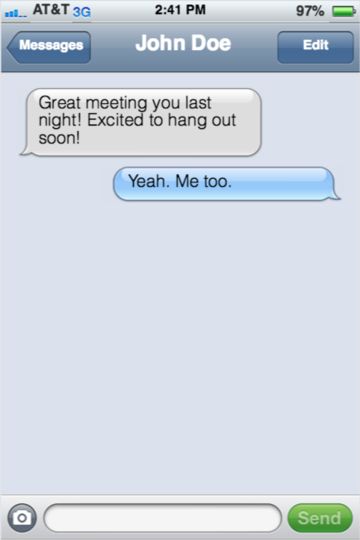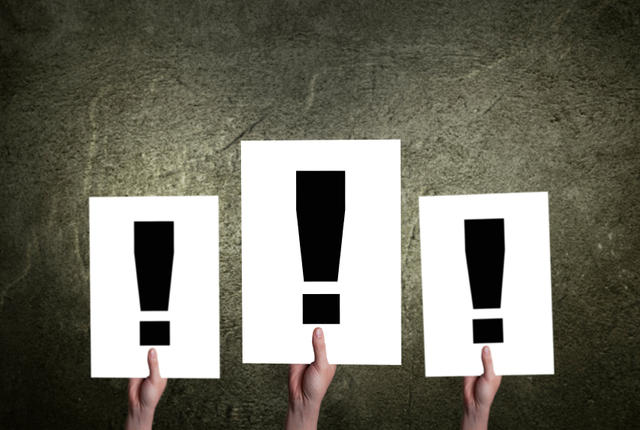The Rise of the Exclamation Mark
Finally!!!!!!
By Alec Cudmore, St. Edward’s University
Scott Fitzgerald once said, “An exclamation mark is like laughing at your own jokes,” a sentiment that was echoed to me by high school English teachers.
One comical poster in my 10th grade classroom even berated the exclamation mark at length for its obtrusive nature, quoting several notable writers’ disdain for its, “Hey, look at me” personality. For this reason, I would go to great lengths to avoid the exclamation mark for most of my academic career. I was sure that it carried with it the same shame as the dreaded Comic Sans, a font I once embarrassingly used for the cover of my poetry chapbook, none the wiser to its reputation.
But I’ll impart unto you an important lesson. The older you get, the more likely it is you’ll be communicating over the internet in a professional manner. This usually manifests in the emails we send to superiors, project group members and apartment complexes. More and more, adults communicate solely through text messaging and Outlook.
After years emailing and texting students, professors and establishments, imagine my surprise to see not one, but several adults using exclamation marks in their emails.

What was this blasphemy? English professors were laughing at their own jokes, it seemed. Grown men were shouting at me in text form. Even more odd was the fact that, despite the hatred built around this form of punctuation in my previous education, I at no point felt any disproval for those using it; in fact, I often found myself hoping the exclamation mark would pop up.
The mark had this fascinating way of transforming what would be a cold statement into something warm and approachable, evolving a calculated response into one more genial and kind.
Soon enough, I started using it too. Here’s what I learned about the surprisingly versatile exclamation mark.
1. You Can Never Go Back
Once I started busting out my EM’s, friends took note of my more laid-back demeanor. My sentences did a much better job of conveying my non-aggressive, understanding nature. If I rationed my use of EMs properly, they wouldn’t grow tiresome. There would be a fair enough distinction between more banal statements, and the stuff that really needed to pop.
Unfortunately, it wasn’t long until I found myself using the exclamation mark a little too often. The fatigue I was concerned about began to set in, and I found the value and effectiveness of it waning. I found that the moment I began to revert back to more traditionally punctuated statements, whomever I was texting would follow suit. Their responses would grow a little more callous and brief, and would sometimes even result in them asking me, “You okay?”
The “You okay?” showing up when you are perfectly okay has a habit of making you quite suddenly not okay at all. I’d then ask myself, “Am I okay? Should I be upset?”
I’d then start texting in a more confrontational tone, fulfilling their expectations and intuition. The whole conversation would transform into this self-made pity party, one that came about solely because I went back to using fewer exclamation marks.
Remember: When you’ve practiced being mad at someone over text, you’ve likely used brevity as your main weapon. Hence, brevity is often mistaken for anger. The exclamation mark beautifully fixes all of that.
Succinct responses are allowed now, so long as it is indicated that you are in good spirits.
I just didn’t realize that, and after spoiling my friends with the warmth of the EM, failing to use it confused the hell out of them. When had I become so cruel?
Emojis typically carry the same responsibility, but sweeten the pot a little too much. If exclamation marks are the ice cream, emojis are the drizzle of chocolate sauce with an Oreo. If you are deciding to go down the path of an EM-user, or even throw out the occasional emoji, understand that your friends’ perception of your text messages will change forever. I advise you to stay well aware of your position on the spectrum of EM usage. Note that any sudden change in abundance may lead to disruptions in your correspondence and the occasional, “Are you mad at me?”
2. They Add Depth
The exclamation mark is far more self-aware than many of my previous teachers bothered to explain. Unlike “laughing at your own joke,” something people often do unknowingly, exclamation marks are incredibly useful as indicators of mood and tone for a purely textual interaction. They convey a sense of attitude that normally goes unseen over text. Using an EM is not the same as using all-caps to express excitement, it’s far subtler than that.
Consider the phrase, “Don’t make me regret it.”
That can be a haunting thing to say to someone. In the right context, it could be read as a sarcastic inflection with faux-drama, especially among friends. However, with a regular old period and without context, it would leave most with a pit in their stomach. When one throws an exclamation mark on there—“Don’t make me regret it!”—it becomes significantly less daunting, as it implies good humor. Despite the meaning of the phrase, you might expect that this person could forgive you one day for potentially making them regret it.

This doesn’t mean you should take phrases followed by exclamation marks less seriously. Most of the time, they’re used in order to add much-needed levity to otherwise strictly professional communications. When they’re used appropriately, they can indicate a passing understanding that the person you are communicating with is a friend, not simply a contact.
3. Amongst Professionals, Beware a Surfeit
While I am an advocate for the use of exclamation marks, with great power comes great responsibility. Tossing around too many EM’s can leave you seeming a little stale, perhaps even reckless. Repetition is generally a poor way to convey anything in the written word, and capping off statements with three EM’s to indicate extreme excitement really just comes across as immature and confusing.
One exclamation mark does plenty of heavy lifting for you, and is far more versatile; it can be read as warm, interested and receptive. Add two more, and you sound like your parents just bought you your first cell phone.
Just like you wouldn’t want to send an email riddled with typos because it may make you seem incompetent, you also wouldn’t want to sound too casual for fear of seeming presumptuous. Overt casualness gives off the vibe that you are assuming that a far more comfortable relationship exists between you and your contact. If your contact is a superior, this conduct could be viewed as insubordinate and unprofessional.
It is in my professional opinion, however, that the singular use of an exclamation mark, when done in moderation, helps the writer display a grasp on tone and relatability. I would never suggest anyone avoid it too intensely. Always use your critical thinking skills to determine tone for use with certain clients, friends, professors, bosses, etc. It’s always best to tread cautiously when penning your thoughts into transmissions and revision is always recommended.










